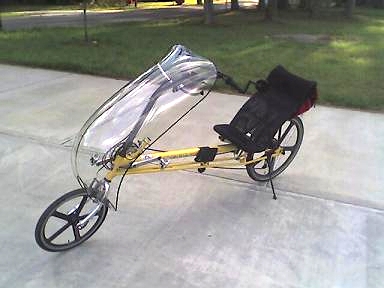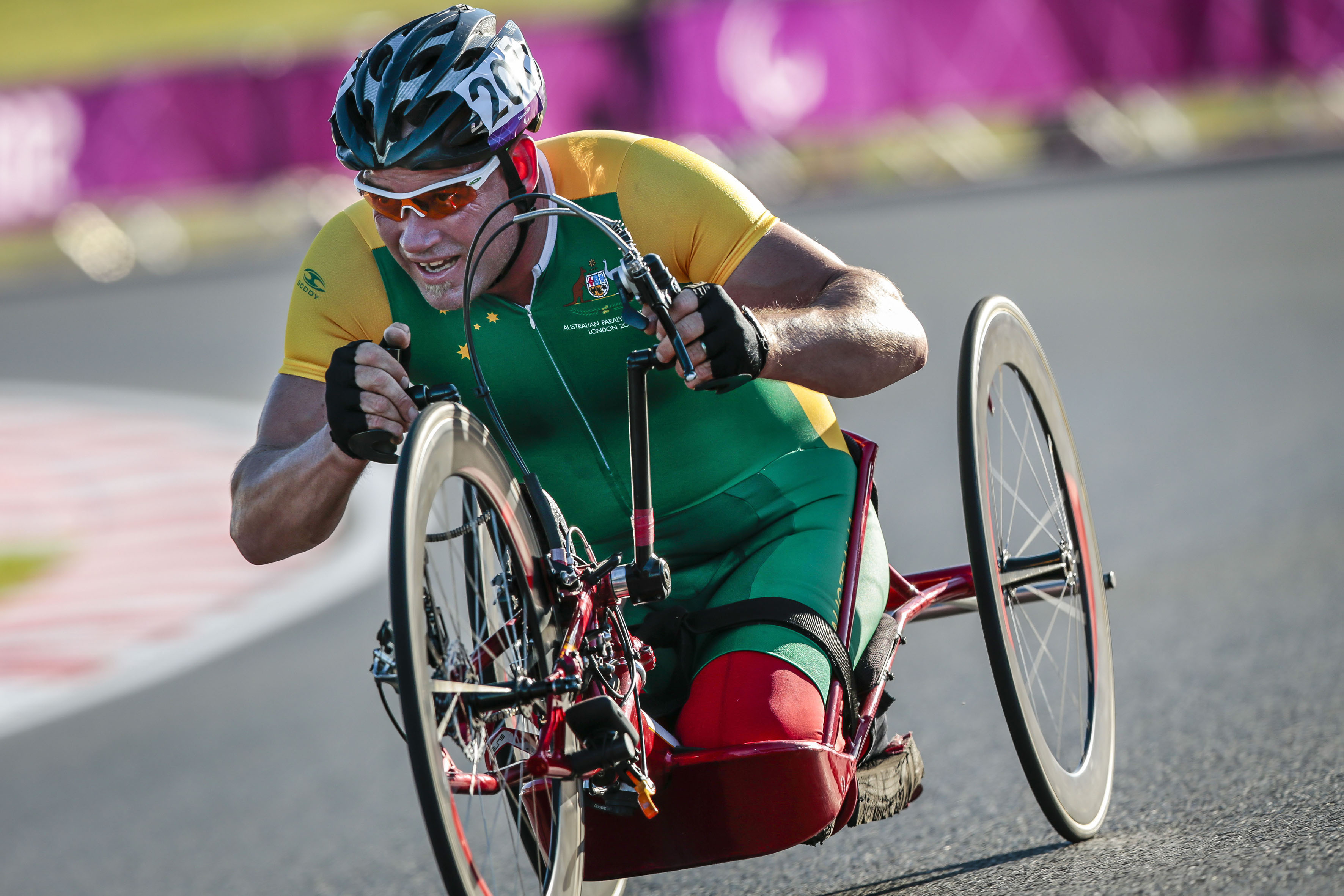|
H5 (classification)
H5 is a para-cycling classification. The UCI recommends this be coded as MH5 or WH5. Definition UCI defines H5 as: "An athlete who can use the kneeling position must use it and therefore will be classified accordingly. * Paraplegic with impairments corresponding to a complete lesion from Th11 or below * Double below or Double through knee amputee * Single leg amputation (AK), minimal disability below knee amputation (BK) * Incomplete loss of lower limb function, with other disabilities, which prevent the safe use of a conventional bicycle or tricycle * Kneeling Position (HK-bike), in case of mobility reduction that prevents kneeling, the athlete can use a recumbent bike in H4 (ex-H3) * Hemiplegic with spasticity grade 2, lower limb more involved * Diplegic, lower spasticity grade 2 in both legs * Mild to moderate athetosis or ataxia The cycle This classification can use an ATP3 knee-seat cycle that is forward leaning on a rigid frame. Classification history Cycling first became ... [...More Info...] [...Related Items...] OR: [Wikipedia] [Google] [Baidu] |
Para-cycling Classification
Para-cycling classification is the process of classifying participants in para-cycling covering four functional disability types. The classification system includes classes for handcycles for people who have lower limb mobility issues. The sport is governed by the Union Cycliste Internationale (UCI). Definition There are fourteen classifications based on functional disability type. The blind classifications are based on medical classification, not functional mobility classification. File:B1 class.png, Visualisation of functional vision for a B1 (classification), B1 competitor File:B2 class.png, Visualisation of functional vision for a B2 (classification), B2 competitor File:B3 class.png, Visualisation of functional vision for a B3 (classification), B3 competitor File:Wheelchair_rugby_profile_classification_C5-6.svg, Functional mobility range of an H1 (classification), H1 classified cyclist File:Wheelchair_rugby_profile_classification_C6-7.svg, Functional mobility range of an H2 ( ... [...More Info...] [...Related Items...] OR: [Wikipedia] [Google] [Baidu] |
Paraplegia
Paraplegia, or paraparesis, is an impairment in motor or sensory function of the lower extremities. The word comes from Ionic Greek () "half-stricken". It is usually caused by spinal cord injury or a congenital condition that affects the neural (brain) elements of the spinal canal. The area of the spinal canal that is affected in paraplegia is either the thoracic, lumbar, or sacral regions. If four limbs are affected by paralysis, tetraplegia or quadriplegia is the correct term. If only one limb is affected, the correct term is monoplegia. Spastic paraplegia is a form of paraplegia defined by spasticity of the affected muscles, rather than flaccid paralysis. The American Spinal Injury Association classifies spinal cord injury severity in the following manner. ASIA A is the complete loss of sensory function and motor skills below the injury. ASIA B is having some sensory function below the injury, but no motor function. In ASIA C, there is some motor function below the level of ... [...More Info...] [...Related Items...] OR: [Wikipedia] [Google] [Baidu] |
Recumbent Bicycle
A recumbent bicycle is a bicycle that places the rider in a laid-back reclining position. Most recumbent riders choose this type of design for ergonomic reasons: the rider's weight is distributed comfortably over a larger area, supported by back and buttocks. On a traditional upright bicycle, the body weight rests entirely on a small portion of the Tuberosity of the ischium, sitting bones, the feet, and the hands. Most recumbent models also have an aerodynamics, aerodynamic advantage; the reclined, legs-forward position of the rider's body presents a smaller frontal profile. A recumbent holds the world speed record for a bicycle, and they were banned from racing under the Union Cycliste Internationale (UCI) in 1934, and now race under the banner of the World Human Powered Vehicle Association (WHPVA) and International Human Powered Vehicle Association (IHPVA). Recumbents are available in a wide range of configurations, including: long to short wheelbase; large, small, or a mix ... [...More Info...] [...Related Items...] OR: [Wikipedia] [Google] [Baidu] |
Spasticity
Spasticity () is a feature of altered skeletal muscle performance with a combination of paralysis, increased tendon reflex activity, and hypertonia. It is also colloquially referred to as an unusual "tightness", stiffness, or "pull" of muscles. Clinically, spasticity results from the loss of inhibition of motor neurons, causing excessive velocity-dependent muscle contraction. This ultimately leads to hyperreflexia, an exaggerated deep tendon reflex. Spasticity is often treated with the drug baclofen, which acts as an agonist at GABA receptors, which are inhibitory. Spastic cerebral palsy is the most common form of cerebral palsy, which is a group of permanent movement problems that do not get worse over time. GABA's inhibitory actions contribute to baclofen's efficacy as an anti-spasticity agent. Cause Spasticity mostly occurs in disorders of the central nervous system (CNS) affecting the upper motor neurons in the form of a lesion, such as spastic diplegia, or upper motor neu ... [...More Info...] [...Related Items...] OR: [Wikipedia] [Google] [Baidu] |
Diplegia
Diplegia, when used singularly, refers to paralysis affecting symmetrical parts of the body. This is different from hemiplegia which refers to spasticity restricted to one side of the body, paraplegia which refers to paralysis restricted to the legs and hip, and quadriplegia which requires the involvement of all four limbs but not necessarily symmetrical. Diplegia is the most common cause of crippling in children, specifically in children with cerebral palsy. Other causes may be due to injury of the spinal cord. There is no set course of progression for people with diplegia. Symptoms may get worse but the neurological part does not change. The primary parts of the brain that are affected by diplegia are the ventricles, fluid filled compartments in the brain, and the wiring from the center of the brain to the cerebral cortex. There is also usually some degeneration of the cerebral neurons, as well as problems in the upper motor neuron system. The term diplegia can refer to any ... [...More Info...] [...Related Items...] OR: [Wikipedia] [Google] [Baidu] |
Athetosis
Athetosis is a symptom characterized by slow, involuntary, convoluted, writhing movements of the fingers, hands, toes, and feet and in some cases, arms, legs, neck and tongue. Movements typical of athetosis are sometimes called ''athetoid'' movements. Lesions to the brain are most often the direct cause of the symptoms, particularly to the corpus striatum. This symptom does not occur alone and is often accompanied by the symptoms of cerebral palsy, as it is often a result of this physical disability. Treatments for athetosis are not very effective, and in most cases are simply aimed at managing the uncontrollable movement, rather than the cause itself. Signs and symptoms Athetosis can vary from mild to severe motor dysfunction; it is generally characterized by unbalanced, involuntary movements of muscle and a difficulty maintaining a symmetrical posture. The associated motor dysfunction can be restricted to a part of the body or present throughout the body, depending on the indiv ... [...More Info...] [...Related Items...] OR: [Wikipedia] [Google] [Baidu] |
Ataxia
Ataxia is a neurological sign consisting of lack of voluntary coordination of muscle movements that can include gait abnormality, speech changes, and abnormalities in eye movements. Ataxia is a clinical manifestation indicating dysfunction of the parts of the nervous system that coordinate movement, such as the cerebellum. Ataxia can be limited to one side of the body, which is referred to as hemiataxia. Several possible causes exist for these patterns of neurological dysfunction. Dystaxia is a mild degree of ataxia. Friedreich's ataxia has gait abnormality as the most commonly presented symptom. The word is from Greek α- negative prefix+ -τάξις rder= "lack of order". Types Cerebellar The term cerebellar ataxia is used to indicate ataxia due to dysfunction of the cerebellum. The cerebellum is responsible for integrating a significant amount of neural information that is used to coordinate smoothly ongoing movements and to participate in motor planning. Although a ... [...More Info...] [...Related Items...] OR: [Wikipedia] [Google] [Baidu] |
1988 Summer Paralympics
The 1988 Summer Paralympics () were the first Paralympics in 24 years to take place in the same city as the Olympic Games. They took place in Seoul, South Korea. This was the first time the term "Paralympic" was used officially. Bidding process During the fourth meeting of the International Paralympic Committee held at the Aylesbury Civic Center in England (28 July 1983), two candidate cities made themselves known; * Seoul, South Korea, under the initiative of Dr. Whang Youn Dai * Melbourne, Australia, under the initiative of Dr. John Grant The ICC sent to both cities a questionnaire in order to gauge both cities' interest, as well as their preparedness for hosting such an event, with both candidates given one year to respond. In the end, only Seoul returned with a completed document; as Melbourne did not respond to the ICC. At the same time, a political movement in Australia to have Brisbane host the 1992 Summer Olympics and Paralympic events weakened the case for Mel ... [...More Info...] [...Related Items...] OR: [Wikipedia] [Google] [Baidu] |
International Paralympic Committee
The International Paralympic Committee (IPC; german: Internationales Paralympisches Komitee) is an international non-profit organisation and the global governing body for the Paralympic Movement. The IPC organizes the Paralympic Games and functions as the international federation for nine sports. Founded on 22 September 1989 in Düsseldorf, West Germany, its mission is to "enable Paralympic athletes to achieve sporting excellence and inspire and excite the world". Furthermore, the IPC wants to promote the Paralympic values and to create sport opportunities for all persons with a disability, from beginner to elite level. The IPC has a democratic constitution and structure and is composed of representatives from 182 National Paralympic Committees (NPCs), four international organizations of sport for the disabled (IOSDs) and five regional organizations. The IPC's headquarters is located in Bonn, Germany. Overview On the basis of being able to organize the Paralympic Games more ... [...More Info...] [...Related Items...] OR: [Wikipedia] [Google] [Baidu] |
2016 Summer Paralympics
) , nations = 159 , athletes = 4,342 , opening = 7 September , closing = 18 September , opened_by = President Michel Temer , cauldron = Clodoaldo Silva , events = 528 in 22 sports , stadium = Maracanã , summer_prev = London 2012 , summer_next = Tokyo 2020 , winter_prev = Sochi 2014 , winter_next = Pyeongchang 2018 The 2016 Summer Paralympics (), the 15th Summer Paralympic Games, were a major international multi-sport event for athletes with disabilities governed by the International Paralympic Committee, held in Rio de Janeiro, Brazil, from 7 to 18 September 2016. The Games marked the first time a Latin American and South American city hosted the event, the second Southern Hemisphere city and nation, the first one being the 2000 Summer Paralympics in Sydney, and also the first time a Lusophone (Portuguese-speaking) country hosted the event. These Games saw the introduction of two new sports to the Paralympic program: canoeing and the ... [...More Info...] [...Related Items...] OR: [Wikipedia] [Google] [Baidu] |
Stuart Tripp
Stuart Tripp (born 13 June 1970) is an Australian cyclist. He won a silver medal in the Men's Road Time Trial H5 at the 2016 Rio Paralympics and competed at the 2020 Tokyo Paralympics. Personal Tripp was born on 13 June 1970 in Traralgon, Victoria. His right leg was amputated following a 1994 car accident that had left him in a coma for several weeks after the initial accident. The accident happened when he was 23 years old and also resulted in both his legs being broken. Neither drugs nor alcohol were causes and his seatbelt helped save his life. Following his accident, he turned to alcohol and smoking cigarettes as a form of coping but he eventually stopped using both. Tripp is a qualified plumber and has degrees in science and adult learning and development. He is also an accomplished author, with an autobiography titled 'Travelling Hopefully' published in 2007. Tripp has competed in the New York City Marathon in the handcycle class. , he lives in Northcote, Victoria. He ... [...More Info...] [...Related Items...] OR: [Wikipedia] [Google] [Baidu] |
Alex Zanardi
Alessandro "Alex" Zanardi (; born 23 October 1966) is an Italian professional racing driver and paracyclist. He won the CART championship in 1997 and 1998, and took 15 wins in the series. He also raced in Formula One from 1991 to 1994 and again in 1999; his best result was a sixth-place finish in the 1993 Brazilian GP. He returned to CART in 2001, but a major crash in the 2001 American Memorial resulted in the amputation of his legs. He returned to racing less than two years after the accident; competing in the European Touring Car Championship in 2003–2004 and then in the World Touring Car Championship between 2005 and 2009, scoring four wins. In addition to continuing to race cars, Zanardi took up competition in handcycling, a form of paralympic cycling, with the stated goal of representing Italy at the 2012 Summer Paralympics. In September 2011, Zanardi won his first senior international handcycling medal, the silver medal in the H4 category time trial at the UCI World ... [...More Info...] [...Related Items...] OR: [Wikipedia] [Google] [Baidu] |




